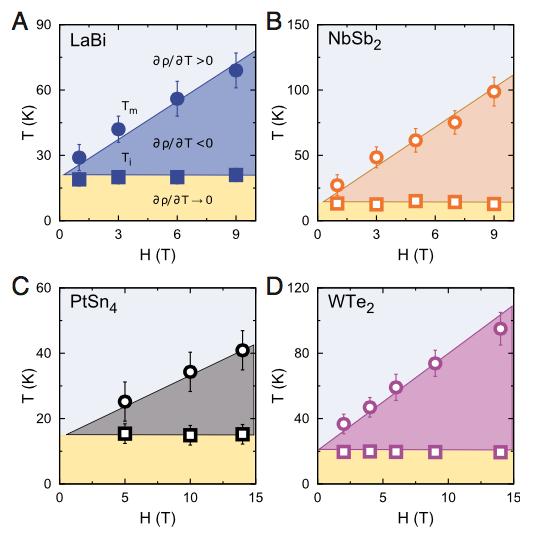Underlying connection found between diverse materials with extreme magnetoresistance

Resistance-temperature-applied-magnetic-field diagrams of materials exhibiting extreme magnetoresistance are shown. Credit: Cava lab
A new study from the Cava lab has revealed a unifying connection between seemingly unrelated materials that exhibit extreme magnetoresistance, the ability of some materials to drastically change their electrical resistance in response to a magnetic field, a property that could be useful in magnetic memory applications.
“The chemistry of these materials looks completely different but they're connected on a profound level by their physics,” said Robert Cava, the Russell Wellman Moore professor of chemistry and corresponding author on the work published in the Proceedings of the National Academy of Sciences.
Numerous materials with extreme magnetoresistance have been reported since the Cava lab first discovered extreme magnetoresistance (originally named 'large magnetoresistance' by Nature editors before the research field supplanted it with the current term) in WTe2 two years ago.
But in particular, researchers in the Cava lab noticed that five materials with extreme magnetoresistance yet very different structures and chemical make-up all share the same characteristics when their resistance-temperature-applied-magnetic-field diagrams are measured. This diagram maps the temperature and magnetic field strength at which the material's magnetoresistance turns on and then saturates. Using the phase diagrams as a clue, scientists may be able to identify other materials with extreme magnetoresistance.
Detailed investigations by Fazel Tafti, a former Cava lab postdoc and physics PhD, revealed a common feature related to the materials' electronic structures, leading the researchers to propose a picture of the underlying physics that unifies these chemically disparate materials. This kind of research, where materials chemistry and materials physics meet, is what the Cava lab and its collaborators enjoy the most, Cava said.
“Now we hope that other people will think about this, and make more measurements to see whether our proposal for the unifying physics holds up to more intense scrutiny,” Cava said. He was confident that first author Fazel Tafti, now an assistant professor of physics at Boston College, would get to the bottom of this phenomenon. “Physicists quest for truth,” he said.
###
Read the full article here:
Tafti, F. F.; Gibson, Q.; Kushwaha, S.; Krizan, J. W.; Haldolaarachchige, N.; Cava, R. J. “Temperature-field phase diagram of extreme magnetoresistance.” Published online before print June 7, 2016.
This research was supported by the Gordon and Betty Moore Foundation under the EPiQS program, Grant GBMF 4412 and the ARO MURI on topological insulators, Grant W911NF-12-1-0461.
Media Contact
All latest news from the category: Materials Sciences
Materials management deals with the research, development, manufacturing and processing of raw and industrial materials. Key aspects here are biological and medical issues, which play an increasingly important role in this field.
innovations-report offers in-depth articles related to the development and application of materials and the structure and properties of new materials.
Newest articles

High-energy-density aqueous battery based on halogen multi-electron transfer
Traditional non-aqueous lithium-ion batteries have a high energy density, but their safety is compromised due to the flammable organic electrolytes they utilize. Aqueous batteries use water as the solvent for…

First-ever combined heart pump and pig kidney transplant
…gives new hope to patient with terminal illness. Surgeons at NYU Langone Health performed the first-ever combined mechanical heart pump and gene-edited pig kidney transplant surgery in a 54-year-old woman…

Biophysics: Testing how well biomarkers work
LMU researchers have developed a method to determine how reliably target proteins can be labeled using super-resolution fluorescence microscopy. Modern microscopy techniques make it possible to examine the inner workings…





















